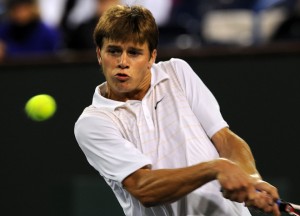Just looking at Ryan Harrison or poring over his numbers does little or nothing to excite comparisons with the last American teenager to launch a top-10 career — Andy Roddick.
Roddick is taller by a couple inches, physically stronger and regularly pounds serves in the 130s. Also, Roddick was already ranked in the mid-40s when he was as old as Harrison, who is now 18 years and 10 months and ranked No. 152. Moreover, Roddick had earlier success in major ATP tournaments than Harrison has had. And Roddick five months before his 19th birthday had beaten Pete Sampras, at Key Biscayne in 2001.
But watching this young man throughout this Indian Wells 1000 tournament, there are instantly things about him which remind you of Roddick at 18.

Like Roddick, he is intensely competitive, and, like Roddick, it’s undeniable that he is narrowly focused on maximizing his potential. There are dozens of extremely talented players who will tell you how committed they are. Very few, in fact, really are committed enough to reach top 10.
There are U.S. players, most notably Mardy Fish and Sam Querrey, who were not sufficiently committed to achieving elite status when they were as young as Harrison. And Taylor Dent, though I think he badly wanted to be great, could have been a lot more committed to his physical training when he was a teenager.
None of that is not going to be a worry with Harrison, who quite obviously has invested himself completely in tennis, both on and off the court. That doesn’t guarantee greatness, but it’s a critical foundation and, combined with his talent, I think Harrison is going to have a major future on the ATP tour.
He won three rounds at Indian Wells, defeating Jeremy Chardy, Guillermo Garcia-Lopez and, in his biggest win to date, Milos Raonic. He went out in the round of 16 to Roger Federer, but played pugnacious, no-intimidation tennis in a 7-6, 6-3 loss.
It was particularly gratifying to see Harrison’s performance vs. Federer because it was in such sharp contrast to what we got from another aspiring American, Donald Young, who, after upsetting No. 5 Andy Murray, was heavily disappointing in a bad loss to Tommy Robredo.
The most important thing we got out of Harrison in the Federer match was competitiveness, a word that too often gets lost among the various analyses of a players’ forehands, backhands or services. There are no mechanics involved with “competitiveness” and it’s largely intangible. It’s about how badly you want to win.
I love the tangibles in Harrison’s game — his balance, his running, his solid baseline play off both sides, his surprising aggressiveness in coming to net. But if there is one thing I value about Harrison’s game above everything else, it’s his competitiveness.
He loves to compete, and don’t ever under-value that quality.
Where can he improve? Everywhere. His height is fine at 6-feet and he appears to have a physically strong base — the all-important lower body. But he can get a lot stronger, and he will.
Service: He’s capable of snapping off some 130s, but he hits his firsts more generally in the 110-116 range. As he gets stronger, his service speed will increase. Second serve is good, hardly great, but he backs it up well with his first ground stroke off the returns.
Forehand: Big, penetrating and accurate. Looks like a young Jim Courier out there with his penchant for inside-outs.
Backhand: Farther along at this point than Roddick’s was at 18. He’s got a backhand-down-the-line and he’s not afraid to use it. I’m not sure he’s afraid to use anything in the tennis arsenal. He should develop a more effective slice approach if he’s going to continue to press forward to the net.
Return of serve: For one so young, it’s excellent. Sees the ball quickly, blocks back the tough first serves that leave you no time to set up. Good first step to the ball.
Inside the service line: This category includes not just his volleying but those annoying short balls with low bounces that can be very difficult to lift and fire deep for winners. He made one particularly impressive backhand half-volley against Raonic that told you how quick his hands are, but, on balance, his volleying has a long way to go. That’s not a problem, though, because he’s a WILLING volleyer. Unlike too many players at this age, he wants to get to net. He wants to volley, and that’s half or maybe even more than half the battle to becoming an outstanding volleyer.
Coachability: Obviously very high. His father put in the foundation of his game, but the time has come to pass Ryan on to a full-time traveling coach, though the family isn’t sure who that will be. Certainly there are candidates out there and, because Ryan trains at the IMG Bollettieri Academy in Bradenton, Fl., there will be no lack of interim help. Personally, I’d like to see what Todd Martin, the retired former U.S. top 10, could do for him.
Ryan takes 90 ranking points out of Indian Wells and that should shoot him up to low 120s from his current No. 152. The next stop is Key Biscayne, which is where Roddick, at 18, had his first successes, beating Marcelo Rios and Sampras on the way to the quarters.
Maybe this will be coming-out party for Harrison, too. But do yourself and Ryan a favor. Don’t call him “the next great American tennis star.” Just let him develop on his own schedule.
